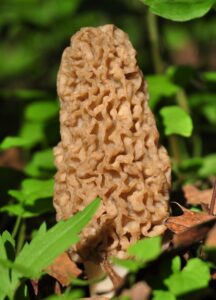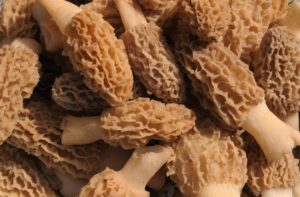Photography courtesy of Lowell Washburn, all rights reserved.
The much-anticipated, spring mushroom season is underway. And although several mushroom species are edible, the famed morel reigns as undisputed king. Exactly when morels populations will achieve peak numbers is an ever-popular topic of debate. There are some trustworthy indicators. Two of the most reliable are temperature and moisture. In order to fruit, morel mushrooms need heat. An ideal climate would provide nighttime temps in the low to mid-50s with daytime highs reaching 70 degrees or above. High humidity along with a few well-timed showers will greatly bolster the annual crop. But although these factors can narrow your search window, they are less than absolute.
Although universally loathed by ultra-urbanized lawn care fanatics, the lowly dandelion is the only absolute rock solid, will-never-ever-let-you-down predictor of when morel mushrooms will annually reach their peak. When the first bright yellow dandelion flowers appear on open lawns or pastures, [those growing along foundations or sidewalks don’t count] you can start your clock — the countdown to sizzling skillets of morels has begun. In precisely 10 to 12 days after the first dandelions open their buds, the peak of the spring morel crop will be standing in the woods, silently awaiting your arrival. As sure as brown trout eat mayflies, you can take this tip to the bank – every single time. If I was ever forced to name the number one key for finding a batch of fresh morels, flowering dandelions would be it.
The month of May is a wonderful time to enjoy our Iowa woodlands. While in search of mushrooms, hunters will also encounter beautiful scenery, woodland wildflowers, and the birding is never better than it is right now. Masters of camouflage, it’s a well-known fact that morel mushrooms can be exceedingly difficult to spot. But human hunters do have one distinct advantage over this highly elusive plant. To paraphrase former President Ronald Reagan, “They can hide, but they can’t run.”



 Tom Cope
Tom Cope Sue Wilkinson
Sue Wilkinson Susan Judkins Josten
Susan Judkins Josten Rudi Roeslein
Rudi Roeslein Elyssa McFarland
Elyssa McFarland Mark Langgin
Mark Langgin Adam Janke
Adam Janke Joe Henry
Joe Henry Kristin Ashenbrenner
Kristin Ashenbrenner Joe Wilkinson
Joe Wilkinson Dr. Tammy Mildenstein
Dr. Tammy Mildenstein Sean McMahon
Sean McMahon